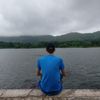
I have recently been reading several papers looking at the idea of 'Humans V Nature' and the sustainable way we can sustain both and allow them to grow. In our current modern world this seems near impossible, as the greedy, consumerist nature of the West takes opportunities and investment from the rest of the world, or at least it can be seen like that. However, a bigger element of this reading that has stood out for me though is the key element of population and population growth to unsustainable and unequal growth. This element of the world could actually be seen to be the cause of, and solution to many problems.
Firstly there is simply the idea of supporting and feeding a growing population, whether we look at it internationally and across the global or simply one country at a time. However, we could break it down more into the two regions of the world which have been identified by anthropologists as well as economists, and that is the north/south and east/west divide, where one side is benefitting while the other is having anything but. Purely through population growth, we see lower growth in the north and west then we do in the south and east, yet the north and west consume far more, demand far more and overall could be seen to do more un-sustainable damage to nature and the environment at a higher density. This is while populations in the north and east grow more and far faster, but demand more, they may live with lower quality lifestyles and simply demand food and water and may not have the insatiable need for 'things' that we see in the north and west. These differing cultures both put strains on nature in different ways. While the east and south populations grow due to cultural traditions, they still turn more land into cropland and take it away from nature, they contaminate more water and flatten more areas to house their growing populations. That is while the north and west have a lower growth rate, but each person has a higher need for 'things'. They put more pressure on resources, they may fund child labour and human rights issues, while they benefit from high amounts of high expense products. Overall then in these simple terms it can be seen how the differing cultures of the west and east and north and south both harm nature as they populations grow and demand more.
Population growth can also lead to a lack of interaction between people and nature, and therefore lowers the value they put on it. While the indigenous of the world have slow population growth rates, they understand how to use nature to their benefit while not over-exploiting it. This is in contrast to those who live in a developed society who may demand electronics more than they demand a nice garden area, or open spaces. People tend to demand anything else but open land they have to look after, that may not be productive for them in monetary terms. While the value of land increases, the value of nature doesn't.
This leads on to the need to house any population. As a population grows increased housing is needed, whether it is cheap and quickly built versions shown in areas like the UK to the more shanty-town-esque quickly built areas seen in Africa and Asia, these may not be as substantial in singular size but they add up to large swathes of natural land changed into poor housing which may also be unsafe for those living in it.
These are simply a few quick examples of what population growth can lead to, and shows the pressure it can put on nature and the value it can take of the environment. Many look to nature for profit, they took to flatten it for housing, to annihilate it for business and to dig and burn it for resources. This need to take from nature means we give little back, with only the few replacing tress, putting nutrients back in to soil and leaving land to re-wild. As population growth increases, whether slow or fast, this effect continues and worsens. Now how we fix this issue is difficult. Do we let the diseases of today prevail, a positive check needed to bring our populations back into balance, an idea seen by Malthus many years ago. Or do we put restrictions on births? Do we allow areas to flood and people to drown, do we allow climate change to increase drought periods and let people both dehydrate and become un-fed? We only have to look at those last few questions to see how horrible a point this really is.
Yet surely we live in a modern world? A world where through technology, knowledge and productivity we can allow both a positive population growth while nature can remain safe and more generations can learn to love it instead of building on it. These are big ideas but ideas that we may have to face soon nonetheless. For today I leave you with the idea that we have technology today that can bring people back from the brink of death, technology that can be used to power the world, surely we can use this ingenious nature to work out how to house our populations sustainably, quickly and safely? I believe we can anyway.
